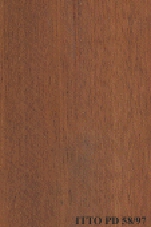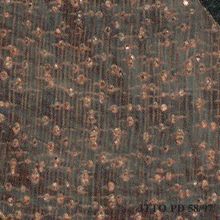
MUIRAPIRANGA (Brosimum rubescens)
Trade Name
Muirapiranga
Scientific Name
Brosimum rubescens Taub.
Family
MORACEAE
Common Names
Bloodwood; Palo De Oro; Legno Satino; Ferolia; Satinholz; Doekaliballi; Satijnhout; Siton Paya; Satine Rubane; Satine Rouge; Muirapiranga (Brazil); Satinwood; Conduru; Falso Pau Brasil (Brazil); Pau Rainha (Brazil); Amapá Rana (Brazil); Satine; Satiné
Scientific Name Synonyms
Piratinera rubescens (Taub.) Pittier; Alicastrum rubescens (Taub.) Taub.
Description Of The Tree
Botanical Description
This tree is reported to have commercial lengths up to 17 m, with diameters from 45 to 60 cm. The boles are straight and cylindrical. It has abundant creamy latex.
Natural Distribution
The species is reported to be regionally common within its range, which includes the Guyanas and the lower Amazon basin. In Brazil it occurs in the Para, Amazonas, Mato Grosso and Rondonia states.
Wood Identification
Anatomic Description Of Wood
Wood diffuse porous. Vessels solitary and in short radial multiples. Tangential diameter of vessel lumina 200 micras or more (large). Tyloses common. Vessels per mm2 less than 6 (rare). Simple perforation plates. Vessel-ray pits similar to intervessel pits in s Axial parenchyma aliform. Axial parenchyma confluent. Occasionally prismatic crystals in non-chambered axial parenchyma cells. Axial parenchyma bands under 4 per mm. 4 to 10 rays per mm (medium). Rays 1 to 4 seriate. Occasionally prismatic crystals in the ray cells. Occasionally heterogeneous rays and/or multiseriate heterogeneous rays. Body ray cells procumbent with over 4 rows of upright and/or square marginal cells (Kr Fibers with simple to minutely bordered pits.
-
 Wood Macro Photo Tangential Plane
Wood Macro Photo Tangential Plane
-
 Wood Micro Photo Of Transversal Section
Wood Micro Photo Of Transversal Section
Availability
Cites Status
Unrestricted
General Wood Description
Odor
Odor or taste are typically indistinct.
Color
The sapwood is not clearly demarcated from the heartwood. The heartwood is usually deep red or pale reddish-brown in color.
COLOR INDEX (1=Black, 7=Light yellow,white)
3
Grain
The grain is straight to slightly interlocked.
Texture
The wood is medium to fine textured.
Luster
It is not a lustrous wood.
Natural Durability
It is resistant to attack by decay-causing organisms, termites, and dry wood insects.
Natural durability index (1= Very high durability, 7=Vey low durability)
1
Resistance To Impregnation
The heartwood is considered to be moderately difficult to preserve. The sapwood is easier to preserve.
Wood Physical Properties
Basic Density or Specific Gravity (O.D. weight/vol. green) (g/cm³)
0.95
Air-dry Density (Weight and volume at 12%MC) (g/cm³)
1.11
Total shrinkage Tangential (Saturated to 0%MC) (%)
6.8
Total shrinkage Radial (Saturated to 0%MC) (%)
4.7
Dimensional stability ratio (Total Tangential Shrinkage %/Total Radial Shrinkage %)
1.4
Wood Chemical Properties
Wood Mechanical Properties
Bending Strength (MOR),12%MC (kgf/cm²)
1497
Stiffness (MOE) 12%MC (kgf/cm²)
193214
Compression parallel to fiber 12%MC (kgf/cm²)
939
Compression perpendicular to fiber 12%MC (kgf/cm²)
125
Shear strength radial 12%MC (kgf/cm²)
137
Janka hardness (side) 12%MC (kgf)
918
Janka hardness (end grain) 12%MC (kgf)
1070
Workability
Sawing
The wood is reported to be moderately difficult to saw.
Rotary Veneer Cutting
It is reported to be interesting for slicing, but thermal treatments are recommended.
Sliced Veneer
It is reported to be interesting for slicing, but thermal treatments are recommended.
Blunting Effect
Blunting effect on cutting tools is rated as moderate.
Planing
Planing operations are reported to be rather difficult.
Turning
30
Nailing
Pre-boring is required before nailing or screwing.
Gluing
Gluing properties are reported to be good.
Finishing
It is easy to finish.
Polishing
The wood has good polishing characteristics.
Response To Hand Tools
B. rubescens is moderately difficult to work with hand tools.
REFERENCED USES
End Uses Summary
FURNITURE AND CABINETS, TURNING, OTHER AND MUSICAL INSTRUMENTS
Furniture Cabinets
- 21 - Tropical timbers of the world. Part III-Southeast Asian and Oceanian Species.
Turning
- 30 - Embassy of Honduras in Japan
Other & Musical Instruments
- 63 - Madeiras do Brazil II
Please Provide Information To View Producer Information